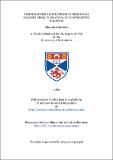Files in this item
Temperature adaptations in perennial grasses from climatically contrasting habitats
Item metadata
| dc.contributor.advisor | Crawford, R. M. M. | |
| dc.contributor.author | Schneider, Albrecht | |
| dc.coverage.spatial | vi, 181 p. | en_US |
| dc.date.accessioned | 2018-06-20T14:28:08Z | |
| dc.date.available | 2018-06-20T14:28:08Z | |
| dc.date.issued | 1980 | |
| dc.identifier.uri | https://hdl.handle.net/10023/14353 | |
| dc.description.abstract | This thesis investigates physiological mechanisms underlying temperature adaptations in perennial grasses. A comparative approach was employed by using pairs of species that have been collected from lowland sites in thermally contrasting habitats up to 2000 km apart on a north-south direction. The population samples from northern latitudes, i.e. from cooler climates, had higher growth rates at 12°C than southern provenances. Dark respiration rates between 5 and 25°C did not differ between provenances; but acclimatization at 10°C increased the respiration rate in all northern population samples, whereas some southern population samples reduced their respiration rate as a response to acclimatization at 10°C. Northern provenances showed a greater activity of carbohydrate formation in light after periods of 48 hours starvation in darkness. This property could be attributed to the higher activity of RuBP-carboxylase in northern genotypes. No evidence was found that the higher activities are due to higher enzyme concentrations in these genotypes. The enzyme exhibited lower energies of activation in northern provenances in the range 5 - 15°C Activation energies for succinate dehydrogenase in isolated mitochondria were higher for northern population samples in the range 10 - 25°C. Higher specific activities were found for malate dehydrogenase from northern plants between 5 and 25°C. In this temperature range the apparent energies of activation were lower for northern plants. The enzyme displayed positive thermal modulation in both northern and southern provenances. Temperature changes had generally a greater effect on northern provenances. The significance of these findings is discussed in the light of previous reports in the literature and in relation to a possible advantage in the plant's native habitat. | en_US |
| dc.language.iso | en | en_US |
| dc.publisher | University of St Andrews | |
| dc.subject.lcc | QK755.S6 | en |
| dc.subject.lcsh | Plants—Effect of temperature on | en |
| dc.title | Temperature adaptations in perennial grasses from climatically contrasting habitats | en_US |
| dc.type | Thesis | en_US |
| dc.type.qualificationlevel | Doctoral | en_US |
| dc.type.qualificationname | PhD Doctor of Philosophy | en_US |
| dc.publisher.institution | The University of St Andrews | en_US |
This item appears in the following Collection(s)
Items in the St Andrews Research Repository are protected by copyright, with all rights reserved, unless otherwise indicated.

